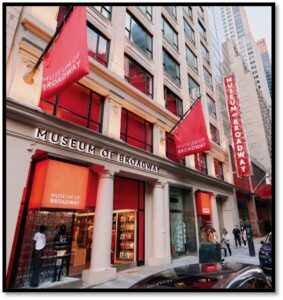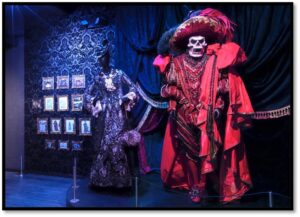The Museum of Broadway – Where All Broadway Shows Unite: Review by Antonia Kasper Hinman

A pink Ziegfeld Follies dressing room; A blue and yellow Westside Story Jets jacket; Oklahoma corn “as high as an elephant’s eye”; A headdress from Hello Dolly (worn by Bette Midler and Bernadette Peters); A flowered, groovy swing reminiscent of the musical Hair; Patti LuPone’s wig from Evita; Paneled mirrors reflecting A Chorus Line; A regally dressed skeleton depicting Phantom of the Opera. These are only snippets of the 26,000 square foot, three floored treasure trove filled with historical artifacts and interactive exhibits inside The Museum of Broadway. Founded by Julie Boardman and Diane Nicoletti, The Museum of Broadway located near Times Square and next to the Lyceum Theatre at 145 West 45th Street in New York City is the much-needed time capsule preserving the Broadway Shows’ past, present and future artifacts, and historical growth. The Museum of Broadway is the “product of all Broadway productions” being the only destination where all Broadway Shows not only intersect but unite.
As the website states, “The Museum of Broadway has teamed up with internationally renowned artists, designers and theatre historians to create an interactive experience that highlights groundbreaking moments in Broadway’s history – the moments that pushed creative boundaries, challenged social norms, and paved the way for those who would follow.” The Museum of Broadway consists of three main parts: The Map Room, A Broadway Timeline and The Making of a Broadway Show. In addition, there’s a studio space for masterclasses and group gatherings and of course, a gift shop with plenty of merchandising goodies. It takes about ninety minutes to walk through the museum though theatre lovers may stay longer to relish this motherload of Broadway memorabilia. The staff is also enthusiastic and helpful in occasionally guiding visitors along the way.
First stop, The Map Room: decorated with a silhouetted Times Square skyline crediting the individuals that helped make the museum happen. After a short film with an overview of the migration of New York City theaters from the financial district to Union Square and Herald Square to Broadway’s permanent home, The Theatre District in midtown. With the help of Disney, the once dirty, dilapidated theatres of 42nd Street were resurrected into their original majestic buildings housing family friendly commercial productions.
And then there’s the map of all 41 Broadway Theaters chronologically aligned from 1732 to the present day with room for future additions.
Next on the museum journey is a series of stops with rooms representing the differing decades of theatre: The Broadway Timeline (the bulk of the museum). Winding corridors lead into various rooms that are thematically designed and staged by pertinent Broadway designers with the visual etchings and audible echoing’s of words, songs, and music from a variety of production hits.
The first room is a pink dressing room reminiscent of the legendary Ziegfeld Follies designed by Sam and Ryan Ratelle. On display are feathered costumes, an original showgirl’s tiara with gold shoes and purse. Floating visitors into another area the song Show Boat’s “Ol’ Man River” can be heard reminding us of the earliest of American musicals. Oklahoma has a room designed by Ann Marie Coolick filled with corn stalks “as high as an elephant’s eye.” There’s also a homage to all the Jukebox Musicals represented by a jukebox centered in an area designed by Derek McLane.

The Broadway shows’ timeline often reflects much of our society’s cultural climate in that generation. Including the game changing highs and most challenging lows. (i.e. When Broadway closed for the first time during the Covid pandemic and the staggering numbers of artists deaths during The AIDS crisis). A huge quilt hangs in a room dedicated to those who died from AIDS created in partnership with Broadway Cares/Equity Fights AIDS along with a wall of names honoring those that died from the disease. Tony Kushner’s eye-opening play Angels in America is also featured. Fittingly, a portion of the museum’s ticket sales is donated to Broadway Cares/Equity Fights AIDS.
Representative of the 1980’s, Rent is rendered in a room designed by Paul Clay which features the New York City East Village vibe with videos, a working payphone, and wardrobe garb that was worn by the cast. The Lion King’s exhibit conjures colorful Africa with amazing animal masks and life-sized puppetry. The mysterious Phantom of the Opera room houses the emblematic white mask and sparkling crystal chandelier (which may be switched out for the original chandelier used in the Broadway show that recently closed after a successful thirty-five-year run). Other shows represented in the museum include but not limited to: Fiddler on the Roof, The King and I, Sunday in the Park with George, Funny Girl, Death of a Salesman, Ragtime, An American in Paris, Chicago, Avenue Q, Beauty and the Beast and Hamilton.
Besides the beautifully designed rooms with original artifacts, there are fun interactive and immersive exhibits throughout. The West Side Story room designed by Anna Louizos, features a drug store and the Jets jacket along with an imitation rooftop and dancers shadowed on the wall welcoming museum visitors to join in on the small dance floor. A flowered, groovy swing representing Hair and a neon lit C-shaped chair from the show Company both entice visitors to sit and take selfies. Another notable area in the museum is the interchangeable special exhibit currently honoring Al Hirschfeld, the famous illustrator (with a replica of the barber chair he worked in) and displays his sketchbooks, album covers, show posters, and Playbill covers. There are also portraits of famous actors such as Julie Andrews, Meryl Streep, Liza Minnelli, and John Leguizamo.
Finally, the downstairs floor (designed by David Rockwell) depicts The Making of a Broadway Show (which I personally found the most intriguing part of the museum).
This floor is dedicated to all the Broadway dramatists, technical (lighting and sound) experts, costumers, stagehands, and marketers or all those individuals representing “the bones” behind the production magic. Lighting and sound boards, sign-in sheets, costume illustrations (from concept to product) (page to stage) along with short videos featuring the “behind the curtain” experts explaining what they do and how live productions operate energize this portion of the museum.
The Museum of Broadway is a gorgeous preservation of everything Broadway. And because Broadway Productions are constantly evolving, so will The Museum of Broadway with new installations and exhibits of future theatre. Truly worth the visit! Can’t wait to see what’s next!
Check the website for hours.
The Museum of Broadway
145 West 45th Street
New York, NY 10036
Tickets range from $29-$49.
There are group discount rates, and special senior and student rates.















